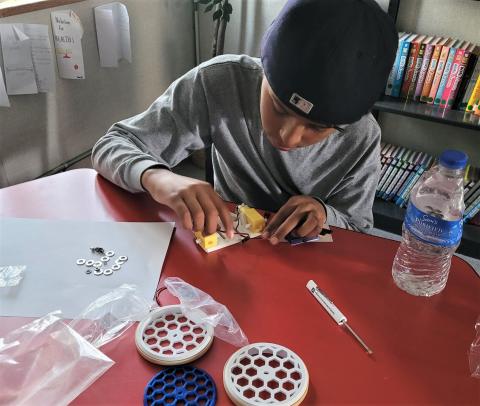Noli Indian School students at the Soboba Reservation had an AISES at UCLA STEM day with virtual sessions in robotics and biology on March 9. The online sessions directed them through building a robot with materials that had been provided by the nonprofit, Every Kid Gets A Robot. EKGAR is a 3D printed robot designed by Daniella Boyer, an Indigenous youth robotics inventor from Michigan. EKGAR is an initiative of The STEAM Connection, a minority and youth-run technical educational organization that designs robots and sends them to kids free of charge.
AISES, the American Indian Science and Engineering Society, is a national nonprofit organization focused on substantially increasing the representation of Indigenous peoples of North America and the Pacific Islands in science, technology, engineering and math studies and careers.
The vision of AISES is for the next seven generations of Native people to be successful, respected, influential and contributing members of our vast and ever-changing global community.
Entering its sixteenth year at the UCLA campus, AISES strives to encourage American Indians to pursue careers as scientists and engineers while preserving their cultural heritage. The goal of AISES is to promote unity and cooperation, provide a basis for the advancement of American Indians all while providing financial assistance and educational opportunities.
AISES devotes most of its energy to its outreach program where members conduct monthly science academies with elementary through pre-college students from Indian Reservations. Serving as mentors and role models for younger students enables AISES at UCLA students to further develop professionalism and responsibility while maintaining a high level of academic and increasing cultural awareness.
Noli’s middle school science teacher Sabrina Sobel said this is the beginning of her students working with UCLA mentors. This program, offered to all science students in grades 6-12, was separate from their regular curriculum but was incorporated into things that they are currently learning or have already learned about. The program was run school-wide with the students completing the STEM workshops with their teachers in other content areas.
“Prior to the start of the school year, UCLA contacted us and wanted to partner with us in the STEM department. Because we had limited access to field trips and guest speakers, we had to shelve this idea,” Sobel said.
However, having it implemented as virtual sessions turned out to be highly successful.
“The students were very excited about the program,” Sobel said. “Next time, they would like to have the UCLA team come to the school for in-person activities. We had all of the middle school students and a large portion of high school students participate.”
While learning how to assemble and work a robot improved engineering, math and technology skills, a session on native plants addressed the science component. High school science teacher Jay Dagostino has been working with his biology students on identifying invasive plants growing near the school campus. They are learning how to plant native varieties and eradicate non-native ones.
“The (AISES at UCLA) native plant lesson in the morning was good supplementary information about native plants that students worked with in science and culture classes,” Dagostino said. “The robot activity was a fun hands-on project for the students.” Sobel said the students were able to play a Kahoot game with students from other schools to test their initial knowledge of native plants.
“The robots were a successful hands-on learning activity since several of the students had to troubleshoot and change the wiring of the system to get them working properly,” she said. “By incorporating this activity, our hope is that this is the start of a strong partnership. We hope to continue working with AISES at UCLA in the future.”
For more information, www.steamconnection.org/ekgar and www.ceed.ucla.edu/aises-page.
Photos courtesy of the Soboba Band of Luiseño Indians




